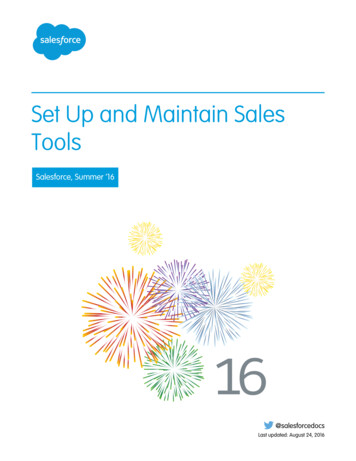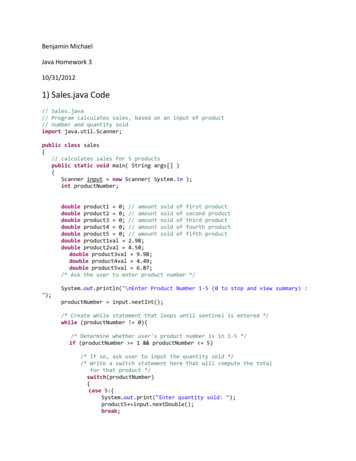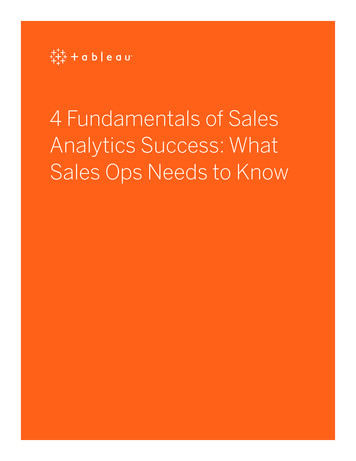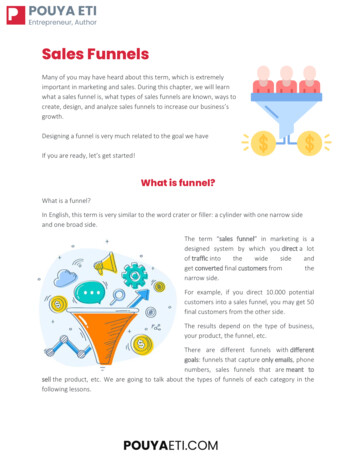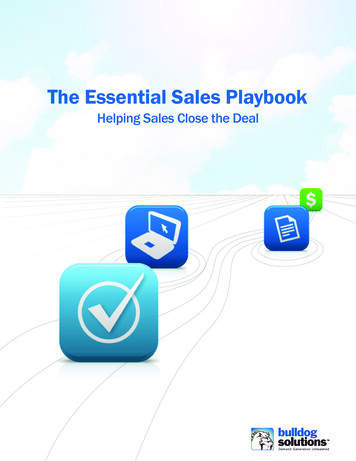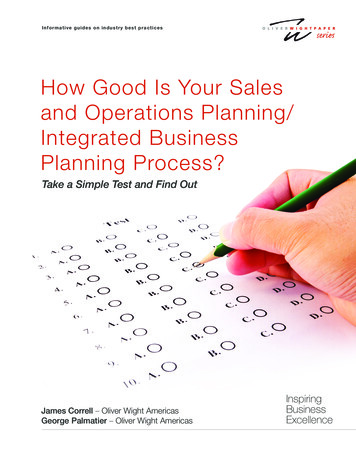
Transcription
Infor mative gu i des on i n du s t r y bes t pr ac t ic e sHow Good Is Your Salesand Operations Planning/Integrated BusinessPlanning Process?Take a Simple Test and Find OutJames Correll – Oliver Wight AmericasGeorge Palmatier – Oliver Wight AmericasInspiringBusinessExcellence
We are often astounded at how many companiesclaim they have a Sales and Operations Planning(S&OP) process, or even the more advancedIntegrated Business Planning (IBP) process,but are not getting the available bottom-lineresults from the process.Upon further investigation, we find that there isa planning process called either S&OP or IBPbut, in practice, it doesn’t measure up to the realmeaning of Sales and Operations Planning orIntegrated Business Planning.Does your company really have an S&OP or IBPprocess, or is it a process in name only? Want toknow where your company stands compared toa best practice S&OP or IBP process?Take this simple test, and see how your companymeasures up to best practice criteria.2HOW GOOD IS YOUR SALES AND OPERATIONS PLANNING/INTEGRATED BUSINESS PLANNING PROCESS?
THE S&OP/IBP TESTRate yourself from 0 to 5, as follows: 5 is the highest rating and means that your company consistently achieves the criteria. 3 means that your company strives to achieve the criteria, but there is need for improvement. 1 means that your company is attempting to put the standard in place. 0 means not doing.RATINGCRITERIAEXPLANATION1) Senior Management owns the process.This means that the highest person in the organization is the owner ofthe management process, including the monthly Management BusinessReview (MBR), and owns the decisions, direction, and approvals that areprovided through the MBR.2) S&OP/IBP is a monthly process.Is the process – and all of its steps – conducted every month, culminatingwith a Management Business Review? Are the reviews, as part of theprocess, scheduled one year in advance?3) The planning horizon is at least 24 months rolling.Is the focus on the entire planning horizon with appropriate informationprovided across the full horizon?4) The focus of each review, as part of the S&OP/IBP process,is beyond three months.Is at least 80% of each review spent discussing months 4 and beyondin the planning horizon?5) Assumptions, risks, and opportunities are documentedand reviewed in each review step.Is a clear picture provided, in which assumptions, risks, and opportunitiesare understood, before giving direction and making decisions?6) The Management Business Review is a direction-settingand decision-making meeting.As part of the preparation for the MBR, are the issues, what-if andcontingency scenarios, and decision recommendations documented?Are decisions made in a timely manner?7) Scenarios are provided when issues emerge.Are multiple, well-thought-out options presented so that alternativescan be considered and the upsides and downsides considered?8) Rough-cut capacity/capability planning is used to projectinternal and external capacity or capability constraints.Are projections of capacity or capability constraints used to validatethat plans are achievable and to take actions to ensure that futurecapacity or capability will exist to support the plans?9) An integration tool, or software, supports the process.Is a tool or software used to provide integrated operational andfinancial information? Does the tool have the ability to provide quickanswers to basic questions?10) The executive team receives answers to the questionsbefore they ask the questions.Are management team members and contributors to the processprepared for questions that arise from the senior management andleadership team?TOTAL SCORE:HOW GOOD IS YOUR SALES AND OPERATIONS PLANNING/INTEGRATED BUSINESS PLANNING PROCESS?3
WHAT DOES YOUR SCORE MEAN?Based on more than 35 years of experience and the results of numerousindependent surveys, here’s what your score means:“According to surveys,more than 50 percentof companies thatimplement S&OP/IBPindicate that a keybenefit is increasedsales revenue.”SCOREIMPACT45-50Very good. Your company should be realizing financial, operational, and customer service benefits from the S&OP/IBP process.40-44Good, but your company is missing opportunities for financial andoperational improvement. You may be working less than optimallyto serve your customers.40 and belowMuch improvement is needed. Significant money is being left onthe table impacting both the top line and bottom line.BENEFITS OF EXCELLENT S&OP/IBPVirtually all companies with the discipline to implement an S&OP/IBP processthat is driven by the leadership team achieve significant benefits to the business.Leadership teams report improved communications and transparency of plans,issues, risks, and opportunities. They also report better ability to anticipate andrespond to change.As a result, these companies experience improved operational and financialresults. Of particular interest is that most leadership teams implement S&OP/IBPwith the objective of improving operational performance. In reality, that is not theonly type of improvement that is common. According to surveys, more than 50percent of companies that implement S&OP/IBP indicate that a key benefit isincreased sales revenue. (See Figures 1-3)4HOW GOOD IS YOUR SALES AND OPERATIONS PLANNING/INTEGRATED BUSINESS PLANNING PROCESS?
Figure 1 Percent of Companies Surveyed Reporting Improvements in the Following Areas:Increased revenue52%Improved forecast accuracy31%Improvements in the perfect order and customer service31%31%Better supply planning and schedule adherenceImproved new product launch28%Reduction of inventoryImproved translation of demand into procurement requirementsor buy-side contract needsCapital planning and asset management27%21%21%Development and execution demand-shaping programs20%Improved logistics planning19%Improved asset utilizationSource: AMR Research17%0%10%20%30%40%50%60%Figure 2 Range of Improvements Cited by CompaniesIMPROVEMENT %IMPROVEMENT %Revenue Growth10-31%Inventory Value33-37%Gross Margin25-29%Inventory Reduction18-46%Demand Plan Accuracy18-43%Safety Stock Reduction11-45%On-Time Delivery In Full10-50%Working Capital25-30%Order Fill Rate29-34%Asset Utilization32-49%Perfect Order22-30%Increased Productivity30-45%Customer Satisfaction29-39%Return on Assets24-30%Inventory Turns24-28%Source: AMR, Aberdeen, Ventana, and Oliver WightFigure 3 Improvement Cited by 40 Oliver Wight ClientsIMPROVEMENT %Increased Forecast Accuracy18-25%Incrased Sales Revenue10-15%Increased On-Time Delivery10-50%Inventory Reduction18-46%Safety Stock Reduction11-45%Increased Productivity30-45%HOW GOOD IS YOUR SALES AND OPERATIONS PLANNING/INTEGRATED BUSINESS PLANNING PROCESS?5
WHAT MAKES THESE BENEFITS POSSIBLE?In our experience, what makes the benefits shown above possible is the “magic”that comes from alignment and synchronization of all functional plans. When plansare not regularly and routinely aligned and realigned, the result is poor operationalperformance in many functional areas.The “magic” with S&OP/IBP is that regular, routine realignment and synchronization of all functional plans bring simultaneous improvement in the functional areas.CASE FOR CHANGEIs your company’s S&OP/IBP process missing opportunities for business improvement or leaving significant money on the table? The leader of one of theworld’s largest logistic organizations has stated, “We are doing a great job withour IBP implementation, but we haven’t accomplished anything until we can‘show the money’.” Improvements to top-line and bottom-line results shouldbe the expected outcome of your S&OP/IBP process.Oliver Wight Americas are the creators of the S&OP process and coined theterm in 1978 in the book Orchestrating Success, Sales & Operations Planningby Walt Goddard and Dick Ling. Since that time, we have improved on theprocess to make it more powerful in driving ever-increasing business improvementsand results.Most of our clients are able to score 45 or higher on the S&OP/IBP test shown inthis paper. They also are able to demonstrate business improvements and financialresults. Using the Oliver Wight implementation methodology, our clients implementor re-implement S&OP/IBP at a record pace. Can we help your company?6HOW GOOD IS YOUR SALES AND OPERATIONS PLANNING/INTEGRATED BUSINESS PLANNING PROCESS?
ONE EXECUTIVE’S VIEW OF S&OP/IBPBy Torkel Rhenman, Chief Executive Officer, Lhoist GroupExcerpted from the book, The Transition from Sales and Operations Planningto Integrated Business Planning.While I was an executive of a business at DuPont in the early 1990s, OliverWight Americas was engaged to assess our Sales and Operations Planningprocess. I looked forward to the assessment because I believed our processwas very good.George Palmatier of Oliver Wight took me aside after reviewing our process.In a very provocative and candid way, he pointed out what I was missing asthe business leader by not having all functions aligned to one plan and by notbeing able to see gaps in the performance of the business.George convinced me that my view of Sales and Operations Planning was toonarrow. We viewed S&OP as mostly a near-term process for balancing demandand supply. George emphasized that our business needed a process for integrating all functions and ensuring that all plans were aligned and tied to strategy.HOW GOOD IS YOUR SALES AND OPERATIONS PLANNING/INTEGRATED BUSINESS PLANNING PROCESS?7
As a business leader, here’s what I found so compelling about IntegratedBusiness Planning: It is so logical, and it truly integrates the financial plan, the financial forecastoutlook, sales and marketing plans, and operations plans. It links tactical plans to the execution of strategy and provides the meansto continually challenge the strategy, rather than continuing to rely on anold and irrelevant strategy as market conditions change. It gives management teams greater confidence in making the decision tochange plans as market and economic conditions change – because theplanning numbers and projections are updated and vetted every month. It is an effective leadership process whether the business is mature,a startup, or a turnaround.“By the time I came to the company, I had threeIntegrated Business Planning implementationsunder my belt and could not imagine running abusiness without the IBP process.”DuPont ended up requiring that all of its businesses implement what was namedDuPont Integrated Business Management (DIBM), DuPont’s name for IntegratedBusiness Planning. The only other mandatory process at DuPont is Six Sigma.That’s how important DIBM was to the health of DuPont.In my final leadership position at DuPont, I served as the chief executive for aturnaround business. By the time I came to the company, I had three IntegratedBusiness Planning implementations under my belt and could not imagine runninga business without the IBP process.8HOW GOOD IS YOUR SALES AND OPERATIONS PLANNING/INTEGRATED BUSINESS PLANNING PROCESS?
I used Integrated Business Planning to bring the entire executive team togetherto focus on delivering the turnaround. Here’s what we accomplished over thecourse of four years: Reduced working capital by 30 percent. Improved forecast accuracy at the item and ship-to level from50 percent to 70 percent. Increased company pretax operating income by five times. Improved the growth rate of this specialty chemical business from3 to 4 percent per year to more than 10 percent per year. Increased the accuracy of our financial plan from being highly inaccurate( 100 percent) to being highly predictable ( 15 percent). Set financial and operational performance records for multiple years.In implementing Integrated Business Planning, I became a better business leader.Most business leaders like to experiment and develop their own processes,which they strive to continually perfect. With Integrated Business Planning,the process has already been perfected. Instead of experimenting, I was ableto use IBP to more efficiently tie together strategy and execution and driveimproved business performance.HOW GOOD IS YOUR SALES AND OPERATIONS PLANNING/INTEGRATED BUSINESS PLANNING PROCESS?9
Infor mative gu i des on i n du s t r y bes t pr ac t ic e sABOUT THE AUTHORSJim Correll, a principal with Oliver Wight Americas since 1984, served eight years as chairman of Oliver WightAmericas and co-chairman of Oliver Wight International. As a consultant, he has assisted more than 20companies attain Class A performance. These companies include numerous Caterpillar divisions, ImperialTobacco, General Dynamics Land Systems, Martin Marietta Astronautics, Boeing Portland, and Tektronix, Inc.At Tektronix, he served as the Class A implementation manager. In that capacity, he developed a new organizational structure, implemented new software, and designed and delivered an effective educational trainingprogram for both the new software and the behavior changes required to obtain bottom-line results. Jim hasan extensive background in instructing public and private courses. In addition to several articles and whitepapers, Jim co-authored two books: Gaining Control: Managing Capacity and Priorities, Third Edition,and the newest Oliver Wight publication, Achieving Class A Business Excellence – An Executive’s Perspective.George Palmatier, Oliver Wight principal, has assisted many companies that make everything from soup to satellites in implementing integrated management processes. He is recognized as an expert on Sales & OperationsPlanning, Integrated Business Planning and demand management as well as ERP, Integrated Supply ChainManagement, and Integrated Product Development (IPD). George works with clients to formalize and integratetheir strategic plans into an integrated business management process, Integrated Business Planning. With twentyyears of experience in sales, marketing, strategic planning, and general management, George has a thoroughknowledge of how to achieve sus
be the expected outcome of your S&OP/IBP process. Oliver Wight Americas are the creators of the S&OP process and coined the term in 1978 in the book Orchestrating Success, Sales & Operations Planning by Walt Goddard and Dick Ling. Since that time, we have improved on the process to make it more powerful in driving ever-increasing business improvements and results. Most of our clients are

